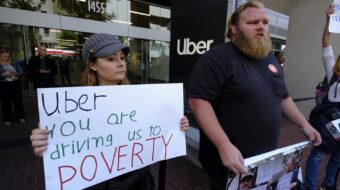CHAMPLIN, Minn. – Jan. 19 was the coldest night of the winter here – so far – but that didn’t deter a roomful of union members from turning out to Champlin City Hall to learn more about a coming threat: a proposed “Right to Work” amendment to the Minnesota constitution.
Union members at the meeting, organized by the Minneapolis Regional Labor Federation, learned the drive to bring “Right to Work” to Minnesota is part of a national campaign funded by the same group of corporate CEOs pushing for similar legislation in other states, including Indiana. Its senate passed a RTW law on Jan. 25.
“It’s a coordinated national effort to take out unions and eliminate working peoples’ voices in the workplace and in politics,” the Minnesotans heard from Adam Robinson, MRLF community and political organizer.
First, however, Robinson posed a question to the group: “What are some of the values and benefits you receive from belonging to a union?”
The room of some 60 union members didn’t need much prompting. People quickly shouted out: A living wage, health care, safety, training, pensions, “building strong communities” and “being treated fairly and respectfully in the workplace.”
One person cited a bumper sticker she saw: “The middle class: Brought to you by your union.”
“These are the things we’re fighting for when we talk about stopping ‘Right to Work,'” Robinson explained.
In the 22 states which currently have “Right to Work” laws, wages for union and non-union workers are an average of $5,538 per year less than in states without such laws. Employers in “Right to Work” states also are less likely to offer benefits like health insurance and pensions. Right to Work legislation is also pending in Indiana.
The broader community suffers, too, when “Right to Work” laws undermine the collective power of workers.
According to the Bureau of Labor Statistics, the rate of workplace deaths is 50 percent higher in “Right to Work” states.
“Right to Work” also impacts public education, bringing lower school funding and larger class sizes. For example, during the 2008-2009 school year, “Right to Work” states spent only $9,005 per student compared to $10,966 in Minnesota.
Robinson said he didn’t like using the anti-union side’s language,”Right to Work.” He noted: “It’s confusing language. It’s misleading and it’s not fair.”
Technically, he explained, so-called “Right to Work” laws prohibit employers and unions from negotiating agreements that make union membership and payment of dues a condition of employment. What people really need to know about “Right to Work,” he said: “It’s an attack on unions and an attack on workers’ rights to collectively bargain.”
On a large screen, Robinson’s PowerPoint presentation projected the language of a possible constitutional amendment in Minnesota: It uses nice-sounding language like “individual freedom to decide.”
The language is so confusing, Robinson said, that even many union members could think “Right to Work” is something they should support. “It’s frustrating as hell to know they’re trying to pull the wool over our eyes,” said James Samuelson of St. Paul, a member of IBEW Local 160.
“If this thing passes, it would be devastating for the whole state,” said Bruce Blasé of Blaine, a member of Pipefitters Local 539. “We don’t want any part of it. We’d end up like South Dakota, North Dakota, Nebraska.”
“You know, this is the beginning of a fight and we need to keep moving forward from here,” Robinson said.
The most important thing, Robinson noted, was for everyone to begin talking to co-workers, neighbors, and friends about the “Right to Work” amendment and how it threatens Minnesota’s middle class. He also encouraged everyone to call their state legislators and tell them, “‘Right to Work’ is wrong for the middle class.”
Passing a “Right to Work” amendment through the legislature requires only a simple majority in both the House and Senate. Gov. Mark Dayton (D) would have no veto and the question would go on the November 2012 general election ballot.
Before adjourning, the group took some time to try putting the message in their own words with practice conversations with the person sitting next to them.
The message about the threat from “Right to Work,” Robinson said, is most effective when coming from a fellow union member. He encouraged people to come to “train the trainer” briefings to learn to become effective messengers. “We need to rise up like Wisconsin did; like Ohio did,” said Robinson. “We can beat this.”
Steve Share is editor of the Minneapolis Labor Review. This story was distributed by Press Associates Inc.












Comments